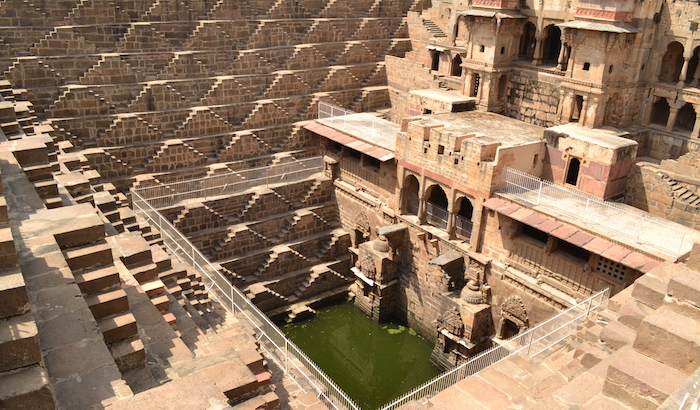Once a month here on the Molten Sulfur Blog, I run content taken from our book Archive: Historical People, Places, and Events for RPGs. This post is one of eighty entries in Archive, each more gameable than the last!
This post is brought to you by beloved Patreon backer Colin Wixted. Thanks for helping keep the lights on! If you want to help keep this blog going alongside Colin, head over to the Patreon page – and thank you!

Chand Baori
1000-Year-Old Stepwell
Built over a thousand years ago, the Chand Baori of Rajasthan, India is one of the largest stepwells in the world. Despite its size, its remoteness often leaves it overlooked. Stepwells, also known as bawdi or baori, are large wells unique to India. They have steps built into their sides so people can descend to reach the water at the bottom. Chand Baori was built sometime during the 8th and 9th centuries by the local king, to give the surrounding areas a dependable source of water. A temple to a goddess of happiness, built later, overlooks the well.
The Chand Baori is 13 stories deep and lined with double flights of stairs on three sides, amounting to a total of 3,500 symmetrical, narrow steps. The base of the well is 20 yards down, with water coating the bottommost stairs. Fresh water became murky and green after years of being unused. Chand Baori functions as both well and cistern. Water seeps in from the porous rock below, but the wide mouth also collects rainwater. The fourth wall has no stairs, but instead boasts a set of pavilions built one atop another with niches hosting sculptures and religious carvings. There is also a royal residence, including rooms for the King and Queen and even a stage for entertainment and performing arts.
The temple adjoining the well serves mainly as a tourist attraction today. It was constructed in the 10th century, after the well, and is dedicated to Harshat Mata, the Happy Mother, or the Goddess of the Sands. Being a goddess of joy and happiness, locals believe she blesses the area with these good feelings. In the 11th century, the sultan Mahmud of Ghazni destroyed the temple, aiming to divide religious beliefs. Despite the destruction, the locals tried to piece the temple back together, though it was never the same. The temple is in ruins, but daily worship is offered to the statue of the deity in the temple, showing that faith has prevailed. The statue of Harshat is protected from all sides by a modern boundary of iron. An annual fair is also held in her honor. The fair lasts three days and attracts devotees and merchants from neighboring villages.
Today, the deteriorating stepwell may seem grim, but it is also gathering more attention. India is facing a water crisis and many seek solutions. Growing urgency for water conservation has triggered present-day efforts to de-silt and reactivate some of the wells across India in hopes they might once again collect and store water. So far, there are no plans to revive Chand Baori, but since it is one of the largest stepwells in the world, the site hasn’t yet been forgotten.
Chand Baori in Play
The Chand Baori would make unforgettable terrain for a combat encounter, with the temple and pavilions acting as great observatory areas. Hazardous edges can lead to perilous falls into murky water. Or perhaps a slumbering evil is contained by the unused water at the bottom, and a drought is weakening the stirring monster’s aquatic shackles. Maybe the temple at the top hosts a being who just wants to spread her glow and brightness, but someone like Mahmud of Ghazni is trying to destroy that. Your PCs could help her overcome her obstacles. Stepwells were also sometimes used as resting spots for travelers to escape exhausting heat. Perhaps your PCs find themselves in need of shelter, and they come across an old stepwell that hasn’t been visited for years. They could rest in the rooms that were once constructed for royalty. Or perhaps your party is enlisted in an effort to reactivate Chand Baori. They would have to explore the temple and the well to assure it is safe. Maybe they find old artifacts, or a hidden room in the royal residence that was blocked off by debris.






